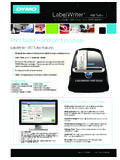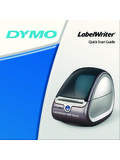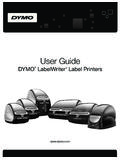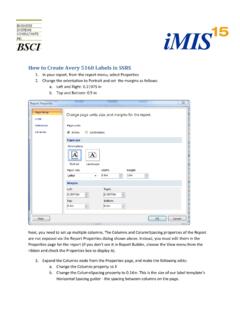Transcription of LabelWriter UserGuide en - DYMO
1 User GuideDYMO LabelWriter label PrintersCopyright 2009-2016 Sanford, All rights reserved. Revised 01 part of this document or the software may be reproduced or transmitted in any form or by any means or translated into another language without the prior written consent of Sanford, and LabelWriter are registered marks in the United States and other countries. All other trademarks are the property of their respective holders. iiContentsAbout the LabelWriter Printer .. 1 LabelWriter Printer Features .. 1 System Requirements.. 3 printing Labels .. 3 Developer and SDK Information .. 3 About Labels.. 5 Loading Labels.. 5 Ordering Labels .. 7 printing Over a Network.. 9 printing to a Shared Printer from Windows .. 9 Sharing a Printer on a Network .. 9 Adding a Network Printer .. 13 printing to a Shared Printer from Mac OS.
2 13 Sharing a Printer on a Network .. 13 Adding a Shared Printer .. 14 Using a Print Server .. 15 Printer Firmware Versions that Support Print Servers .. 16 Caring for Your Printer.. 17 Getting Help.. 19 Troubleshooting .. 19 Status Light.. 19 Performing a Printer Self-Test .. 20 Clearing label Jams .. 20 Correcting Poor Print Quality.. 20 Labels Do Not Feed Correctly .. 20 Printer Does Not Print or Stops printing .. 21 Limited Warranty .. 22 Obtaining Technical Support .. 22 Technical and Environmental Information.. 23 Technical Specifications .. 23 LabelWriter SE450 Printer Technical Specifications .. 24 Device Certification .. 24 Environmental Information .. 25 Documentation Feedback.. 25iii 1 Chapter 1 About the LabelWriter PrinterCongratulations on purchasing a DYMO LabelWriter label printer.
3 Your LabelWriter printer will give you years of reliable label printing . We encourage you to take a few minutes to review how to use and care for your manual provides information about the following printer models: LabelWriter 450 LabelWriter 450 Turbo LabelWriter 450 Twin Turbo LabelWriter 450 Duo LabelWriter 4XL LabelWriter SE450 For complete information about programming and using the LabelWriter SE450 printer, refer to the LabelWriter SE450 Technical Reference Guide, available from the Developers Program page on the DYMO Web site ( ). LabelWriter Printer FeaturesYour LabelWriter printer is a direct thermal printer and does not use ink or toner. Instead, the printer uses heat from a thermal print head to print on specially treated, heat-sensitive labels. Labels are the only supplies you will ever need to familiar with the major components of the 00000-0000000 Top coverLabel spoolLabel releaseLabel feed path and tear barLabel rollLabel guideReverse label buttonForm-feed button and status lightDC power connectorSerial numberCable channelUSB connectorLabelWriter 450 LabelWriter 450 TurboAbout the LabelWriter Printer2 Top coverLabel spoolLabel releaseLabel feed path and tear barLabel rollLabel guideReverse label buttonForm-feed button and status lightS/N 00000-0000000DC power connectorSerial numberCable channelsUSB connectorLabelWriter 450 Twin TurboUSB connectorDC powerconnectorTop coverLabel spoolLabel releaseLabel feed path and tear barLabel rollReverse label buttonForm-feedbutton andstatus lightLabel exit slotLabelWriter 450 DuoOpen label cassette trayLabel guideLabelWriter 4 XLTop coverLabel spoolLabel releaseLabel feed path and
4 Tear barLabel rollReverse label buttonForm-feed button and status lightS/N 00000-0000000DC power connectorSerial numberCable channelUSB connectorSystem Requirements3 The form-feed button on the front of the printer advances a single label . The reverse label button is used to remove labels from the printer when changing rolls. The LabelWriter SE450 printer does not include a reverse label status light visually shows the current state of the printer. Refer to "Status Light" on page 19 for a complete description of the status light. System RequirementsThe LabelWriter printer requires a USB or USB connection and one of the following: Windows XP 32-bit Windows Vista Windows 7 Mac OS or laterTo use the LabelWriter SE450 printer with a serial connection, an RS-232 serial port is LabelsYour LabelWriter printer was shipped with DYMO label software to make designing and printing labels easy.
5 You can also print labels directly from the desktop with QuickPrint, and from Microsoft Word, Excel, and Outlookwith DYMO label Add-ins that are installed when you install DYMO label software. See the DYMO label online Help or Software User Guide for more information on using these and SDK InformationDYMO provides various types of information designed to help developers create products that work with the LabelWriter printers and DYMO label software. Below are some notes for those interested in developing products that work with LabelWriter printers. Keep in mind that LabelWriter printers use standard printer drivers. Therefore, printing to a LabelWriter printer is no different than printing to a laser or inkjet printer, except that the pages are 00000-0000000 Top coverLabel spoolLabel releaseLabel feed path and tear barLabel rollForm-feed button and status lightDC power connectorSerial numberCablechannelSerialconnectorLabelWr iter SE450 USBconnectorAbout the LabelWriter Printer4 In cases where you want to automate printing and take advantage of the label printing power built into DYMO label software, a Software Developer s Kit (SDK) is included in your LabelWriter CD.
6 The SDK provides COM and .NET interfaces. For more information, visit the Developer Program page on the DYMO web site. can check the Developer s forum on the DYMO Web site at for the latest news. Also, you can join the Developer s mailing list to obtain developer-specific news and complete information about connecting the LabelWriter SE450 printer to the host computer or other device, and for information about programming and using the LabelWriter SE450 printer, refer to the LabelWriter SE450 Technical Reference Guide, available from the Developers Program page on the DYMO Web site ( ).5 Chapter 2 About LabelsDYMO LabelWriter printers use advanced thermal printing technology to print on specially treated, heat-sensitive labels. This means you will never have to replace toner, ink cartridges, or a ribbon to print s warranty does not cover malfunction or damage that may be caused by the use of labels other than DYMO-branded labels.
7 Because DYMO LabelWriter printers use thermal printing technology, you must use specially designed and manufactured labels. The thermal coatings used on labels other than DYMO-branded labels may not be compatible, and may provide unsatisfactory printing or cause the printer to long your labels will last depends on how the labels are used. Thermal paper labels, such as those printed by the LabelWriter printer, are susceptible to fading in two ways: Exposure to direct sunlight, to fluorescent light for an extended period of time, or to extreme heat will cause fading. Contact with plasticizers (for example, labels placed on plastic ring binders) will cause the original packaging, the shelf life for LabelWriter labels is 18 months. When labels are used for short-term applications (envelopes, packages, and so on), fading is not a problem. When labels are used to label files in a file cabinet, fading is very gradual over many years.
8 Labels applied to the edge of a notebook that is then placed on a shelf in the sun will show signs of fading within a few prolong label life when labels are not in use, store the labels in a cool, dry place and in the black bag in which they were originally LabelsEach label roll comes in a black plastic bag. Make sure to store the label roll in this bag when the labels are not being LabelWriter Twin Turbo printer holds two label rolls, so you can print two types of labels without having to change the label roll. The LabelWriter Duo printer prints two types of labels: die-cut paper labels (such as Address or Shipping labels) and D1 plastic Labels6 Important!In order for the labels to feed properly during printing , pay attention to the following when loading labels on the spool and into the printer: The label spool guide must be pushed flush against the label roll, with no gap. See Figure 2.
9 The labels must be loaded with the left edge of the label inserted against the left edge of the label feed slot. See Figure 3 and 4 in this section show loading labels in a LabelWriter 450 printer. However, the instructions apply to loading labels in any LabelWriter printer load a label roll1 With the printer plugged in, press the form-feed button to eject the labels that protected the printer during the top cover and remove any packing material inside the label the label spool from inside the cover and separate the spool guide from the spindle. 4 Hold the spool spindle in your left hand and place the label roll on the spindle so that the labels feed from underneath and the left edge of the label roll is firmly against the side of the spool. See Figure the spool guide onto the right side of the spool and press the guide tightly against the side of the label roll, leaving no gap between the roll and the spool.
10 See Figure ensure proper feeding of labels during printing , the label roll must fit snugly against both sides of the label spool, with no gaps. 6 Insert the label spool into the slot in the printer cover with the labels extending from underneath the roll. See Figure the left edge of the label with the left edge of the label feed slot and insert the label into the slot. See Figure printer automatically feeds the labels, stopping at the beginning of the first label . If the printer does not feed the labels, make sure the first label is fully inserted and then press the form-feed the first label on the roll is not a full label , press the form-feed button to eject the partial of the label width, the left edge of the label must be aligned with the left edge of the label feed slot for the labels to feed (450, 450 Turbo, Duo, and Twin Turbo Only) Slide the label guide to the left until the label guide aligns with the right edge of the label .












